Linux从青铜到王者第八篇:Linux基础IO
Posted 森明帮大于黑虎帮
tags:
篇首语:本文由小常识网(cha138.com)小编为大家整理,主要介绍了Linux从青铜到王者第八篇:Linux基础IO相关的知识,希望对你有一定的参考价值。

系列文章目录
前言

一、C语言中文件IO操作
1.文件的打开方式总结
r Open text file for reading.
The stream is positioned at the beginning of the file.
只读方式打开,文件指针指向文件的首位置
r+ Open for reading and writing.
The stream is positioned at the beginning of the file.
读写方式打开,文件指针指向文件的首位置
w Truncate(缩短) file to zero length or create text file for writing.
The stream is positioned at the beginning of the file.
只写方式打开,清空文件内容,如果文件不存在则创建文件,文件指针指向文件的首位置
w+ Open for reading and writing.
The file is created if it does not exist, otherwise it is truncated.
The stream is positioned at the beginning of the file.
读写方式打开,文件不存在则创建文件,如果文件存在则清空原来内容,文件指针指向文章的首位置
a Open for appending (writing at end of file).
The file is created if it does not exist.
The stream is positioned at the end of the file.
以追加写的方式打开,写到文件的结尾处,文件不存在则创建文件,文件指针指向文件的末尾位置
a+ Open for reading and appending (writing at end of file).
The file is created if it does not exist.
The initial file position for reading is at the beginning of the file,
but output is always appended to the end of the file.
以读和追加写的方式打开,文件不存在则创建文件,如果文件存在则从文件的末尾位置开始追加
2.fopen打开文件
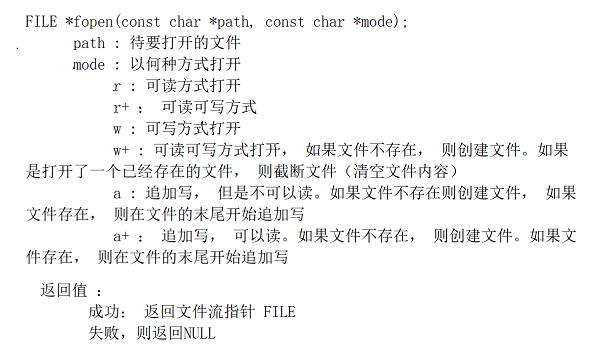
3.fread写文件
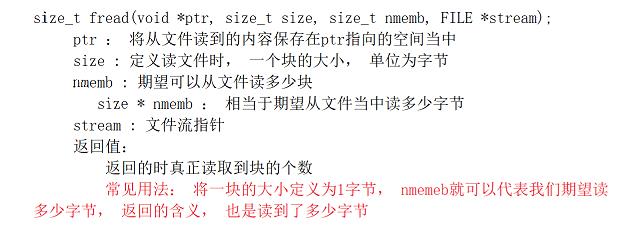
1 #include<stdio.h>
2 #include<string.h>
3 #include<stdlib.h>
4 int main()
5 {
6 FILE* fp=fopen("test.txt","w+");
7 if(fp==NULL)
8 {
9 printf("文件打开失败!\\n");
10 exit(1);
11 }
12 fwrite("bit person!",sizeof(char),11,fp);
13 fseek(fp,0,SEEK_CUR);
14 char arr[100];
15 fread(arr,sizeof(char),strlen(arr),fp);
printf("%s\\n",arr);
16 fclose(fp);
17 return 0;
18 }

4.fwrite写文件
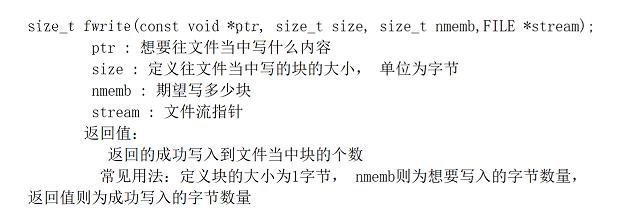
1 #include<stdio.h>
2 #include<string.h>
3 #include<stdlib.h>
4 int main()
5 {
6 FILE* fp=fopen("test.txt","a+");
7 if(fp==NULL)
8 {
9 printf("打开文件失败!\\n");
10 exit(1);
11 }
12 char *arr="bit education!\\n";
13 fwrite(arr,sizeof(char),strlen(arr),fp);
14 fclose(fp);
15 return 0;
16 }

5.fseek移动文件指针

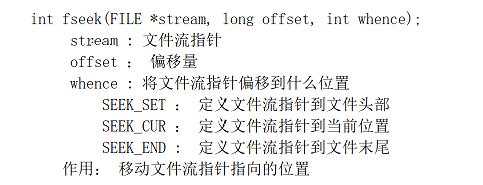
6.ftell获取文件指针当前位置

7.rewind让文件指针回到文件起始位置

8.fcloes关闭文件

9.输出信息到显示器方法
fwrite(msg,strlen(msg),sizeof(char),fp);//往log.txt文件里面写

1 #include<stdio.h>
2 #include<string.h>
3 int main()
4 {
5 FILE *fp=fopen("log.txt","w");
6 if(NULL==fp)
7 {
8 printf("打开文件失败!\\n");
9 }
10 else
11 {
12 /* char c='A';
13 for(;c<'Z';c++)
14 {
15 fputc(c,fp);
16 }*/
17 const char* msg="Hello bit!\\n";
18 // fwrite(msg,strlen(msg),sizeof(char),fp);//往log.txt文件里面写
19 fwrite(msg,strlen(msg),sizeof(char),stdout);//输出,往显示屏上输出
20
21 }
22 fclose(fp);
23 return 0;
24 }
fwrite(msg,strlen(msg),sizeof(char),stdout);//输出,往显示屏上输出

10.stdin & stdout & stderr
- C默认会打开三个输入输出流,分别是stdin, stdout, stderr
- 仔细观察发现,这三个流的类型都是FILE, fopen返回值类型,文件指针

二、系统文件I/O
1.read和write的初次使用
操作文件,除了上述C接口(当然,C++也有接口,其他语言也有),我们还可以采用系统接口来进行文件访问,先来直接以代码的形式,实现和上面一模一样的代码:
写文件

1 #include<stdio.h>
2 #include<stdlib.h>
3 #include<sys/stat.h>
4 #include<fcntl.h>
5 #include<unistd.h>
6 #include<string.h>
7 int main()
8 {
9 int fd=open("myfile",O_WRONLY|O_CREAT,0644);
10 if(fd<0)
11 {
12 printf("文件打开失败!\\n");
13 exit(1);
14 }
15 char* arr="bit education!";
16 write(fd,arr,strlen(arr)-1);
17 close(fd);
18 return 0;
19 }

读文件

1 #include<stdio.h>
2 #include<stdlib.h>
3 #include<string.h>
4 #include<fcntl.h>
5 #include<sys/stat.h>
6 #include<unistd.h>
7 int main()
8 {
9 int fd=open("myfile.txt",O_RDONLY);
10 if(fd<0)
11 {
12 printf("文件打开失败!\\n");
13 exit(1);
14 }
15 char* arr="hello bit!";
16 char buff[100];
17 read(fd,buff,strlen(arr)-1);
18 printf("%s\\n",buff);
19 close(fd);
20 return 0;
21 }

2.接口介绍
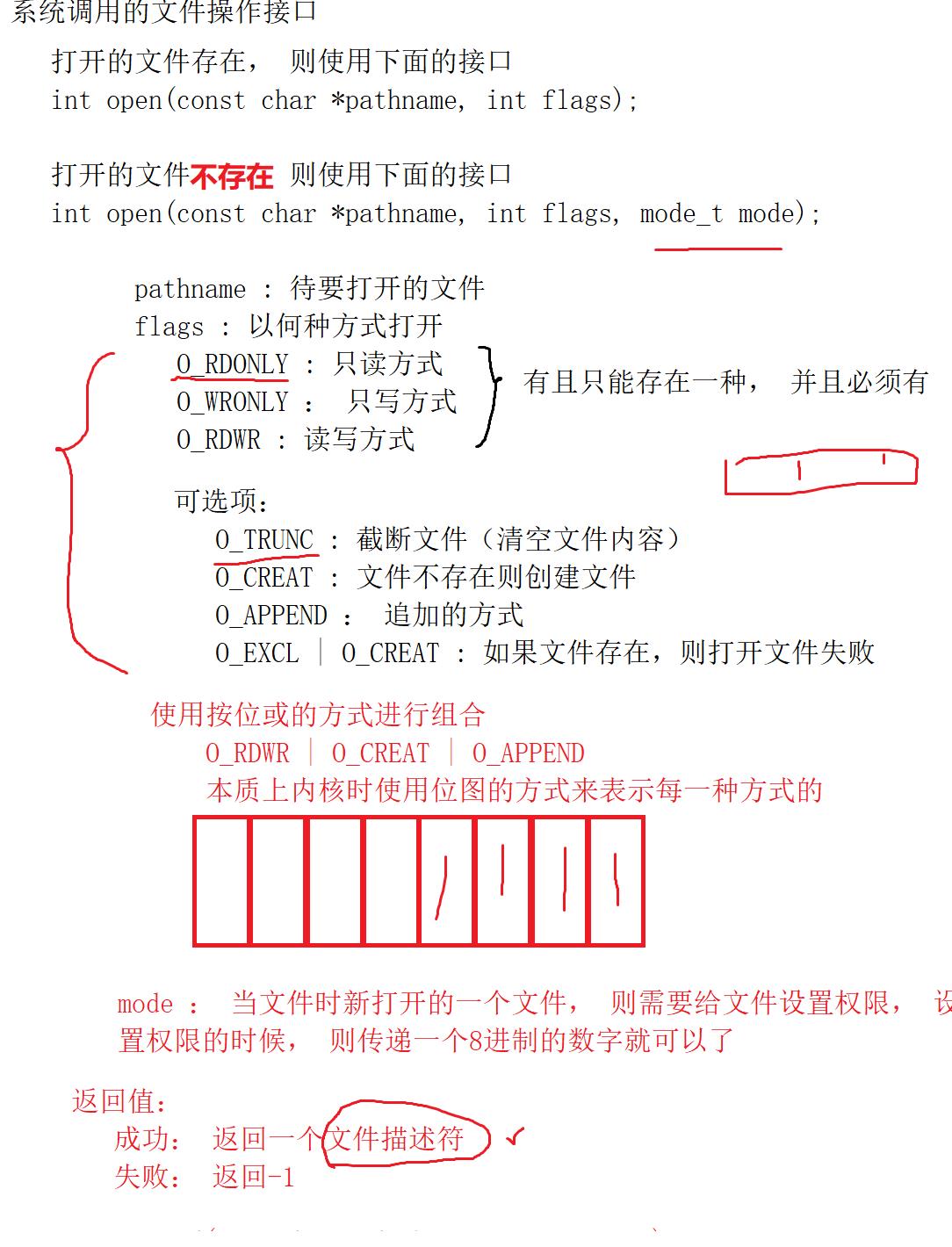
open man open
#include <sys/types.h>
#include <sys/stat.h>
#include <fcntl.h>
int open(const char *pathname, int flags);
int open(const char *pathname, int flags, mode_t mode);
pathname: 要打开或创建的目标文件
flags: 打开文件时,可以传入多个参数选项,用下面的一个或者多个常量进行“或”运算,构成flags。
参数:
O_RDONLY: 只读打开
O_WRONLY: 只写打开
O_RDWR : 读,写打开
这三个常量,必须指定一个且只能指定一个
O_CREAT : 若文件不存在,则创建它。需要使用mode选项,来指明新文件的访问权限
O_APPEND: 追加写
返回值:
成功:新打开的文件描述符
失败:-1
mode_t理解:直接 man 手册,比什么都清楚。

open 函数具体使用哪个,和具体应用场景相关,如目标文件不存在,需要open创建,则第三个参数表示创建文件的默认权限,否则,使用两个参数的open。

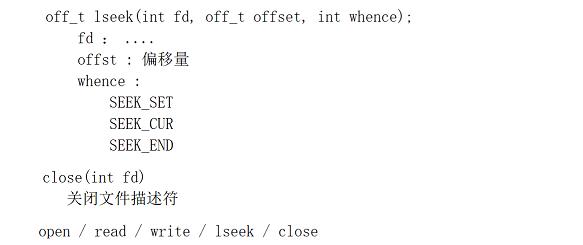
3.open函数返回值
- 在认识返回值之前,先来认识一下两个概念: 系统调用 和 库函数
- 上面的 fopen fclose fread fwrite 都是C标准库当中的函数,我们称之为库函数(libc)。
- 而open close read write lseek 都属于系统提供的接口,称之为系统调用接口。
- 回忆一下我们讲操作系统概念时,画的一张图。
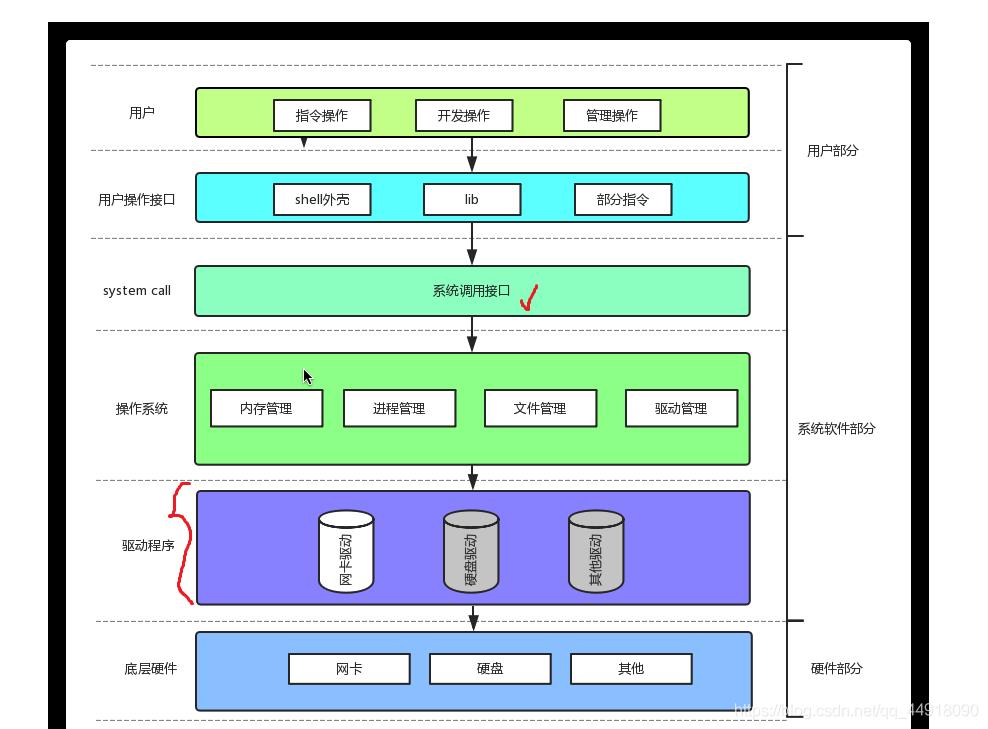
系统调用接口和库函数的关系,一目了然。所以,可以认为,f#系列的函数,都是对系统调用的封装,方便二次开发。
4.文件描述符fd(file descriptor)
- 通过对open函数的学习,我们知道了文件描述符就是一个小整数。
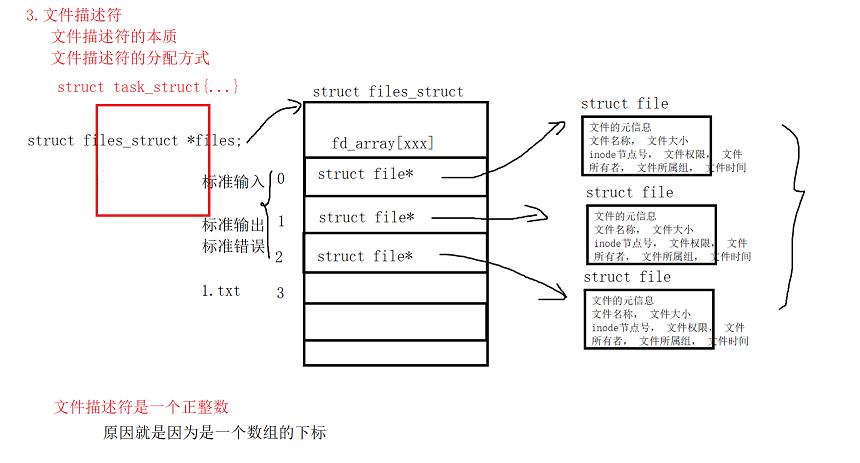
5.0 & 1 & 2

- Linux进程默认情况下会有3个缺省打开的文件描述符,分别是标准输入0, 标准输出1, 标准错误2。
- 0,1,2对应的物理设备一般是:键盘,显示器,显示器。
1 #include<stdio.h>
2 #include<string.h>
3 #include<stdlib.h>
4 #include<fcntl.h>
5 #include<unistd.h>
6 int main()
7 {
8 char buff[100];
9 int fd=read(0,buff,sizeof(buff));
10 write(1,buff,strlen(buff)-1);
11 write(2,buff,strlen(buff)-1);
12 return 0;
13 }

而现在知道,文件描述符就是从0开始的小整数。当我们打开文件时,操作系统在内存中要创建相应的数据结构来描述目标文件。于是就有了file结构体。表示一个已经打开的文件对象。而进程执行open系统调用,所以必须让进程和文件关联起来。每个进程都有一个指针*files, 指向一张表files_struct,该表最重要的部分就是包涵一个指针数组,每个元素都是一个指向打开文件的指针!所以,本质上,文件描述符就是该数组的下标。所以,只要拿着文件描述符,就可以找到对应的文件。
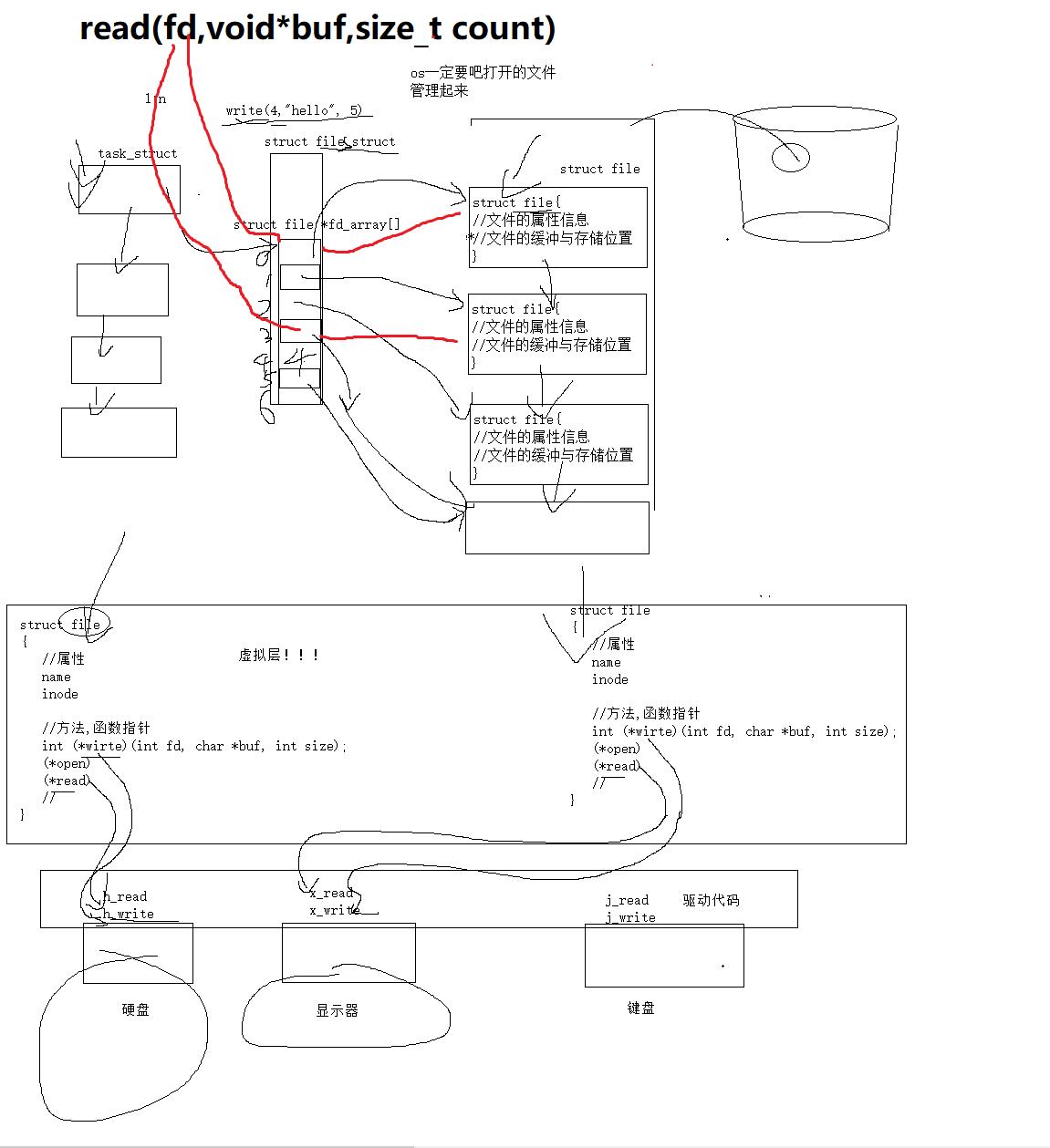
6.文件描述符的分配规则
输出发现fd是3:
1 #include<iostream>
2 #include<fcntl.h>
3 #include<sys/stat.h>
4 #include<sys/types.h>
5 #include<unistd.h>
6 int main()
7 {
8 int fd=open("myfile",O_RDONLY|O_CREAT);
9 if(fd<0)
10 {
11 std::cout<<"文件打开失败!"<<std::endl;
12 }
13 std::cout<<fd<<std::endl;
14 close(fd);
15 return 0;
16 }

关闭0或者2,在看:
1 #include<iostream>
2 #include<unistd.h>
3 #include<fcntl.h>
4 #include<sys/stat.h>
5 #include<sys/types.h>
6 int main()
7 {
8 close(0);
9 // close(2);
10 int fd=open("myfile",O_RDONLY|O_CREAT,0664);
11 if(fd<0)
12 {
13 std::cout<<"文件打开失败!"<<std::endl;
14 return 1;
15 }
16 std::cout<<"fd:"<<fd<<std::endl;
17 close(fd);
18 return 0;
19 }

发现是结果是: fd: 0 或者 fd 2 可见,文件描述符的分配规则:在files_struct数组当中,找到当前没有被使用的最小的一个下标,作为新的文件描述符。
----------------------最小未分配原则----------------------

7.重定向
1.清空重定向
我们发现第一次写的hello world被第二次写的你好呀覆盖了,这就是清空重定向。
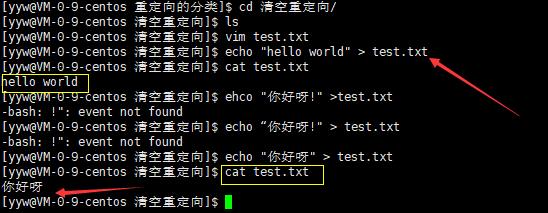
2.追加重定向
我们发现第一次写的hello没有被第二次写的你覆盖,而是追加在hello后面,这就是追加重定向。
3.重定向本质
那如果关闭1呢?看代码:
1 #include<iostream>
2 #include<stdlib.h>
3 #include<unistd.h>
4 #include<fcntl.h>
5 #include<sys/types.h>
6 #include<sys/stat.h>
7 int main()
8 {
9 close(1);
10 int fd=open("myfile",O_WRONLY|O_CREAT,0644);
11 if(fd<0)
12 {
13 std::cout<<"文件打开失败!"<<std::endl;
14 exit(1);
15 }
16 std::cout<<"fd:"<<fd<<std::endl;
17 close(fd);
18 return 0;
19 }

此时,我们发现,本来应该输出到显示器上的内容,输出到了文件 myfile 当中,其中,fd=1。这种现象叫做输出重定向。常见的重定向有:>, >>, <
- 那重定向的本质是什么呢?

8.FILE
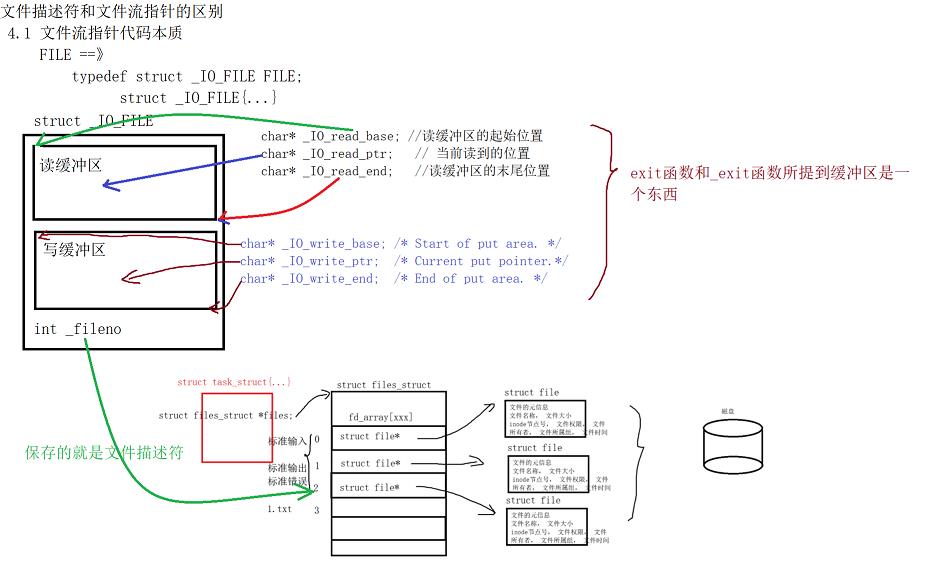
- 因为IO相关函数与系统调用接口对应,并且库函数封装系统调用,所以本质上,访问文件都是通过fd访问的。
- 所以C库当中的FILE结构体内部,必定封装了fd。
来段代码在研究一下:
1 #include<iostream>
2 #include<fcntl.h>
3 #include<sys/stat.h>
4 #include<sys/types.h>
5 #include<string.h>
6 #include<unistd.h>
7 #include<stdio.h>
8 int main()
9 {
10 int fd=open("log.txt",O_WRONLY|O_CREAT|O_APPEND,0644);
11 if(fd<0)
12 {
13 std::cout<<"文件打开失败!"<<std::endl;
14 return 1;
15 }
16 const char* str1="hello printf\\n";
17 const char* str2="hello fwrite\\n";
18 const char* str3="hello write\\n";
19 write(1,str3,strlen(str3));
20 printf("%s\\n",str1);
21 fprintf(stdout,"%s\\n",str2);
22 fork();
23 close(fd);
24 return 0;
25
26
27 }

但如果对进程实现输出重定向呢? ./hello > file , 我们发现结果变成了:
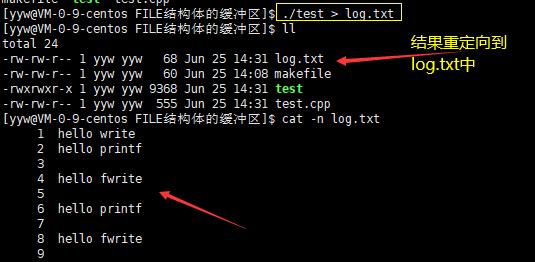
- 我们发现 printf 和 fwrite (库函数)都输出了2次,而 write 只输出了一次(系统调用)。为什么呢?肯定和fork有关!
- 一般C库函数写入文件时是全缓冲的,而写入显示器是行缓冲。
- printf、fwrite库函数会自带缓冲区(进度条例子就可以说明),当发生重定向到普通文件时,数据的缓冲方式由行缓冲变成了全缓冲。
- 而我们放在缓冲区中的数据,就不会被立即刷新,甚至fork之后。
- 但是进程退出之后,会统一刷新,写入文件当中。
- 但是fork的时候,父子数据会发生写时拷贝,所以当你父进程准备刷新的时候,子进程也就有了同样的一份数据,随即产生两份数据。
- write 没有变化,说明没有所谓的缓冲。
综上: printf、fwrite 库函数会自带缓冲区,而 write 系统调用没有带缓冲区。另外,我们这里所说的缓冲区,都是用户级缓冲区。其实为了提升整机性能,OS也会提供相关内核级缓冲区,不过不再我们讨论范围之内。那这个缓冲区谁提供呢? printf fwrite 是库函数, write 是系统调用,库函数在系统调用的“上层”, 是对系统调用的“封装”,但是 write 没有缓冲区,而 printf fwrite 有,足以说明,该缓冲区是二次加上的,又因为是C,所以由C标准库提供。
如果有兴趣,可以看看FILE结构体:
typedef struct _IO_FILE FILE; 在/usr/include/stdio.h
在/usr/include/libio.h
struct _IO_FILE {
int _flags; /* High-order word is _IO_MAGIC; rest is flags. /
#define _IO_file_flags _flags
//缓冲区相关
/ The following pointers correspond to the C++ streambuf protocol. /
/ Note: Tk uses the _IO_read_ptr and _IO_read_end fields directly. /
char _IO_read_ptr; /* Current read pointer /
char _IO_read_end; /* End of get area. /
char _IO_read_base; /* Start of putback+get area. /
char _IO_write_base; /* Start of put area. /
char _IO_write_ptr; /* Current put pointer. /
char _IO_write_end; /* End of put area. /
char _IO_buf_base; /* Start of reserve area. /
char _IO_buf_end; /* End of reserve area. /
/ The following fields are used to support backing up and undo. */
char _IO_save_base; / Pointer to start of non-current get area. */
char _IO_backup_base; / Pointer to first valid character of backup area */
char _IO_save_end; / Pointer to end of non-current get area. /
struct _IO_marker _markers;
struct _IO_FILE _chain;
int _fileno; //封装的文件描述符
#if 0
int _blksize;
#else
int _flags2;
#endif
_IO_off_t _old_offset; / This used to be _offset but it’s too small. /
#define __HAVE_COLUMN以上是关于Linux从青铜到王者第八篇:Linux基础IO的主要内容,如果未能解决你的问题,请参考以下文章